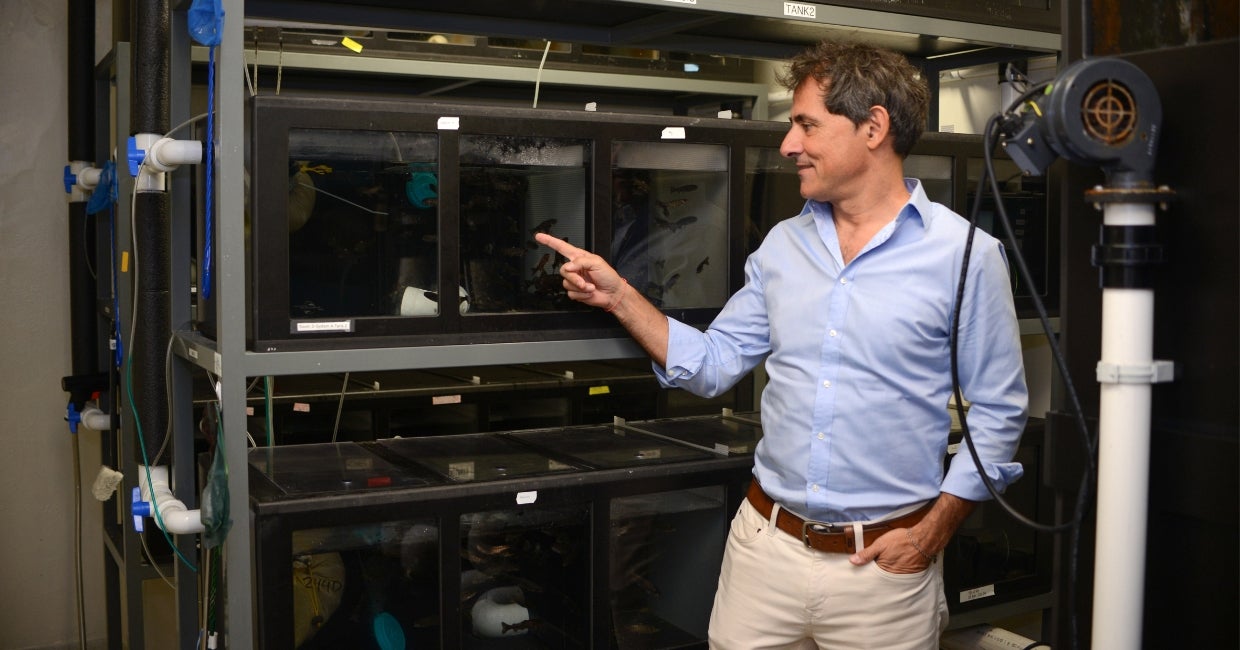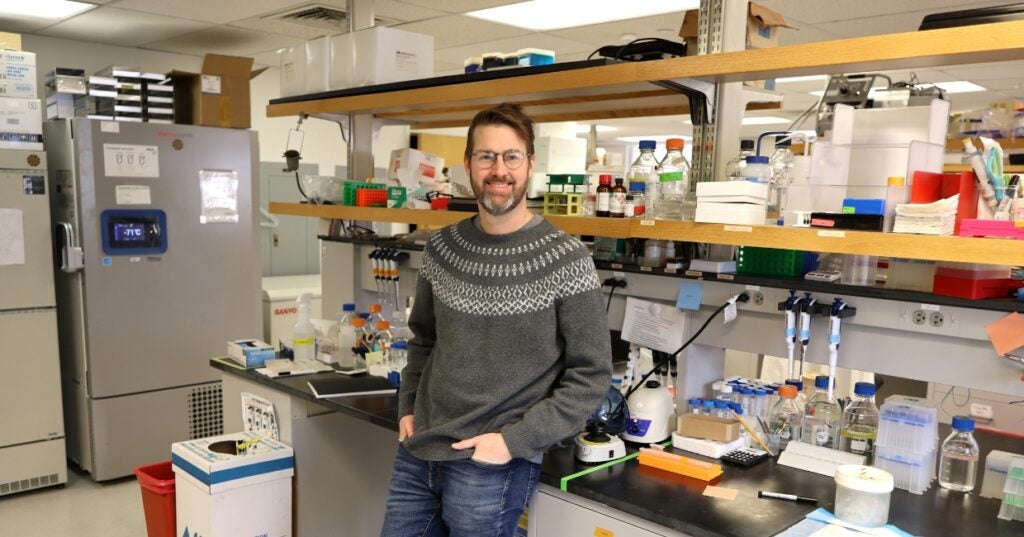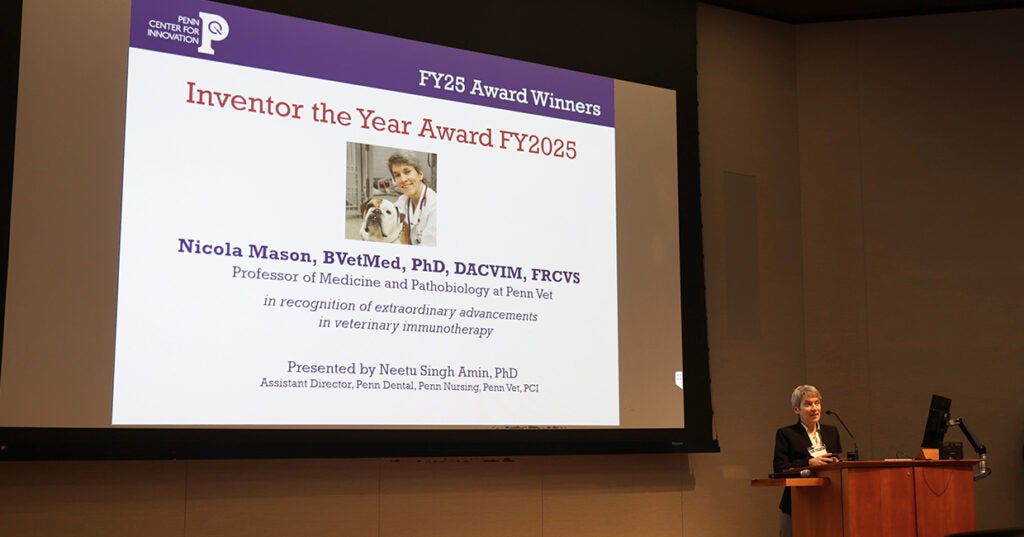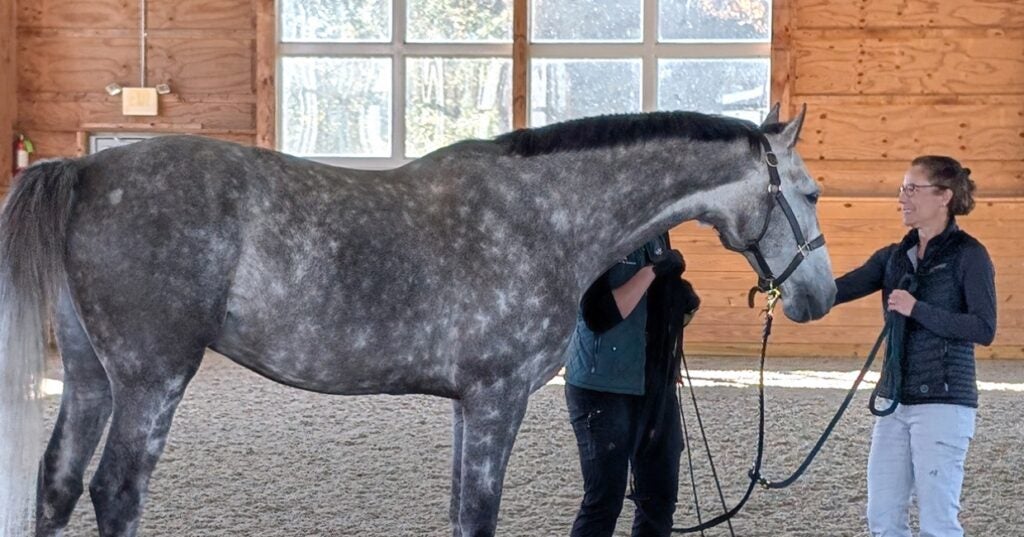Behind the Breakthroughs: J. Oriol Sunyer
What Evolutionary and Comparative Immunology Can Teach Us About Unresolved Paradigms of Fish and Human Immune Systems
J. Oriol Sunyer explores how studying the evolution of the immune system reveals surprising connections between fish and human immunity, and what these discoveries could mean for the development of new therapies for both fish and humans.

Faculty In This Story
Behind the Breakthroughs is a Q&A series that shines a light on the people and ideas driving discoveries across Penn Vet. Each installment offers a glimpse into the work and the curiosity that fuel breakthroughs in basic, translational, and clinical science.
In this inaugural edition, we sit down with Professor of Immunology and Microbiology J. Oriol Sunyer, PhD, whose research dives deep into the origins of adaptive immunity to understand how it first evolved hundreds of millions of years ago in fish. By studying rainbow trout and salmon, he and his team are uncovering surprising connections between fish and human immunity, including how antibodies help shape the composition and functionality of the gut microbiome. Their discoveries challenge long-standing assumptions in immunology and reveal critical clues about host-microbiome interactions as well as the mechanisms of induction of adaptive immune responses. And as global temperatures rise, Sunyer and investigators are beginning to explore what shifting climate patterns could mean for the immune system and health of aquatic species and beyond.
What big problem is your research aiming to solve?
Our main interest is understanding how adaptive immunity, or a body’s learned reaction to foreign substances, has evolved since it first emerged in fish about 400 million years ago. Our main model animal species for such studies are teleost fish, which represent the oldest living bony vertebrates with an adaptive immune system similar to that of mammals. More specifically, our current studies are aimed at understanding how immune-microbiome interactions have evolved from fish to mammals while deciphering the functional consequences derived from this co-evolving process.
Another main interest of ours is elucidating how and where adaptive immune responses at both mucosal surfaces (inner linings of organs and tracks) and secondary lymphoid organs are induced in fish while applying this knowledge towards the development of novel strategies to vaccinate fish. In addition to contributing to the fields of evolutionary and comparative immunology, our studies have allowed us to identify previously unrecognized immune mechanisms in humans that have persisted and remained conserved from fish to mammals.
What is the flagship project that you are working on right now?
This year in Nature Microbiology, we reported the surprising and previously unrecognized key role of the IgM antibody class in regulating the gut microbiome and its metabolism. This finding broke the long-held paradigm that IgA was the key antibody class in performing such roles. Thus, our studies are currently focused on understanding the mechanisms by which IgM (either alone or in coordination with other classes of mucosal immunoglobulins) modulates the composition of the microbiome and its metabolism.
In 2023, in Science Immunology, we reported that adaptive immune responses in fish are induced in germinal center (GC)-like structures, a finding that broke the long-held paradigm that fish did not contain such organized lymphoid microstructures. Thus, another flagship project in our lab is understanding the mechanisms through which these newly discovered GC-like structures are induced and contribute to the production of mucosal and systemic antibody responses against pathogens and microbiota.
What is the one thing you wish more people understood about your field?
The critical importance of studying different non-model species for understanding how the immune system works in mammals, including humans. For instance, we all recognize that laboratory mice represent a critical model species to study so many aspects of mammalian immunology; however, one of the things that this model lacks is IgM in their gut, whereas both humans and fish produce abundant intestinal IgM. As a result, IgM recognizes and coats a very large proportion of the fish and human gut bacteria, but not that of laboratory mice. Therefore, fish are the only tractable animal species in which to study the role of IgM in regulating microbiome homeostasis.
Moreover, studying different immune systems can lead to the discovery of alternative strategies and molecules to fight pathogens. These findings can then be applied not only to the species being studied but also to others, including humans, as shown by translational research on antimicrobial molecules derived from a wide range of animal species.
Finally, the species we study are cold-blooded, which means that they cannot regulate their body temperature, and thus, their physiology is subjected to temperature changes in the environment where they live. As a result, these species are highly susceptible to the abrupt changes in temperature due to climate change, which are likely to have a profound effect on their immune systems, and thus, the survivability of thousands of fish, amphibians, and reptile species. To this end, our group, in collaboration with three other groups, has launched a project to understand the short and long-term consequences of global warming on the immune system of fish as well as on their microbiomes. Such changes are not only expected to threaten the health and survivability of wild fisheries but also that of the fish farming industry.
What is the toughest challenge you face in advancing your work?
Researchers working with fish immune systems face many challenges. Unlike studies with traditional animal models, we cannot just buy ready-made lab materials or kits for our fish. Instead, we must spend a lot of time and effort creating our own specialized tools, like antibodies and lab tests, to study trout and salmon immune cells. We have had to build everything from scratch, including tests to measure immune responses and analyze cells and molecules. The same struggle goes for studying the fish microbiome. This behind-the-scenes work takes years and is often not fully appreciated by reviewers of scientific journals or funding agencies.
Another challenge has been convincing members of the health and science communities that studying fish is instrumental in addressing unresolved paradigms of human immunology. We have uncovered important mechanisms of human immunity through our studies in fish. Something that was not always taken seriously at first. For instance, I remember our first NIH grant submission over 16 years ago; the only comment of a reviewer was something like “I fish and eat rainbow trout”. The reviewer was removed from the panel, and we got the award after resubmitting the same grant.
What is a passion or favorite ritual, outside of your research and work, that helps to keep you grounded and balanced?
There is no one passion favorite, but several. The main rituals or ways to spend my time outside work involve connecting with nature, outdoor adventures, mindfulness practices, and my son. I need weekly hikes in the forest, mountains, my vacation adventures in the jungles, reefs, deserts, mountain peaks, and my visits and friendship with several Indigenous groups. Conscious living and mindfulness practices through piano playing and photography are also key to my well-being. But by far, the most important passion of mine is my son; spending time with him is my favorite way of spending my free time, it erases any bad moments of the day, and keeps me grounded.
Related News

Behind the Breakthroughs: Andrew Vaughan
In this edition, we sit down with Associate Professor of Biomedical Sciences, Andrew “Andy” Vaughan, PhD. Vaughan is a molecular and cellular biologist with a specific interest in lung regeneration.

Penn Vet’s Nicola Mason, BVetMed, PhD, DACVIM, FRCVS, Receives Penn Center for Innovation’s Inventor of the Year Award
The University of Pennsylvania (Penn) School of Veterinary Medicine (Penn Vet) congratulates Dr. Nicky Mason, the Paul A. James and Charles A. Gilmore Endowed Chair Professor and Professor of Medicine…

Behind the Breakthroughs: Amy Johnson
Balancing clinical care with scientific inquiry, Penn Vet’s Amy Johnson leads efforts to decode the complexities of neurologic diseases in horses
About Penn Vet
Ranked among the top ten veterinary schools worldwide, the University of Pennsylvania School of Veterinary Medicine (Penn Vet) is a global leader in veterinary education, research, and clinical care. Founded in 1884, Penn Vet is the first veterinary school developed in association with a medical school. The school is a proud member of the One Health initiative, linking human, animal, and environmental health.
Penn Vet serves a diverse population of animals at its two campuses, which include extensive diagnostic and research laboratories. Ryan Hospital in Philadelphia provides care for dogs, cats, and other domestic/companion animals, handling more than 30,000 patient visits a year. New Bolton Center, Penn Vet’s large-animal hospital on nearly 700 acres in rural Kennett Square, PA, cares for horses and livestock/farm animals. The hospital handles more than 6,300 patient visits a year, while our Field Services have gone out on more than 5,500 farm service calls, treating some 22,400 patients at local farms. In addition, New Bolton Center’s campus includes a swine center, working dairy, and poultry unit that provide valuable research for the agriculture industry.

